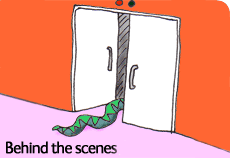Curation
The Museum’s many curators have a crucial role, looking after the collections and making sure they are well-preserved. This helps scientists to study them accurately and, importantly, to re-examine them in future when more advanced techniques become available.
Failure to curate natural history collections properly has meant that specimens no longer exist of some extinct species. Others are so badly preserved that we can’t be sure exactly what they would have looked like. The Dodo is the most famous example, but there are a number of others. Find out about some of them below.
-

Bulinus truncatus - 31/07/2010
Freshwater snails in the genus Bulinus are exceptionally important in Africa as carriers of disease. Species including Bulinus truncatus act as a host for the parasitic worm that causes schistosomiasis - a disease that currently affects 164 million people worldwide. Find out more.
-

Eunoe nodosa - 13/05/2010
Eunoe nodosa is an epi-benthic species of polychaete worm that can be found on marine sediments from the sub-littoral zone to 1,260 meters of water. Find out more about Eunoe nodosa and the project underway to make the Museum's polychaete type collections more accessible.
-

Phormidium pseudpriestleyi - 08/08/2010
Phormidium pseudpriestleyi is a cyanobacterium that is well adapted to life in Antarctica where it is found in lakes and ponds. It protects itself against cold by producing antifreeze compounds, and against intense ultra-violet radiation with pigments that act as UV screens. Find out how you might spot this unusual bacterium.
-

Raphus cucullatus (dodo) - 23/01/2010
The dodo is one of the most famous extinct species in the world, telling a cautionary tale about the consequences human actions can have. Discover what what we know about how this flightless bird lived, and what caused it to go extinct.
-

Rhinatrema bivittatum (two-lined caecilian) - 30/07/2010
Rhinatrema bivittatum is a tropical amphibian from a group known as caecilians. It looks like a large worm and lives in soil. Find out why, and how, Museum scientists are using this species to study the early evolution of caecilians.
-

Solemya velesiana - 11/08/2010
Solemya velesiana is a marine shellfish found in Australian seagrass beds that belongs to an ancient group of clams that date back over 400 million years. It propels itself using an extendable foot and swims by opening and closing its shell. Bacteria are the key to this mollusc’s diet. Read on to find out how Solemya velesiana feeds.
-

Stratiotes aloides - 07/09/2010
The water-soldier, Stratiotes aloides L., is an aquatic vascular plant of the family Hydrocharitaceae. S. aloides is found floating in summer and submerged in winter and its leaves display a notable similarity to those of pineapples. Find out more about Stratiotes aloides L.
-

Tachypodoiulus niger (black millipede) - 26/07/2010
Tachypodoiulus niger is a common millipede found in gardens across Britain. It is known as the black millipede, and sometimes as the white-legged snake millipede. It finds its home in leaf litter and on tree bark and sometimes ventures into houses. Find out what this helpful garden insect likes to eat.
-

Crocodylus anthropophagus (man-eating crocodile) - 08/11/2010
Crocodylus anthropophagus lived alongside hominids in Tanzania nearly 2 million years ago. As its name suggests, it was a man-eating reptile, and some hominid fossils bear tell-tale teeth marks. This ancient crocodile has only recently been named from specimens held in collections in Tanzania, and others here at the Natural History Museum. Discover where this reptile lived, and what makes it unique.
-

Rigidipenna inexpectata (Solomon Islands frogmouth) - 20/12/2010
Rigidipenna inexpectata is a rare bird found only on a few of the Solomon Islands. It is a nocturnal species and remains hidden in forested regions, but makes characteristic whistling sounds to communicate. Read on to discover more about this typical frogmouth and the threats it faces from deforestation.
Toolbox

Last year nearly 100,000 specimens were loaned to scientific institutions and researchers worldwide.
